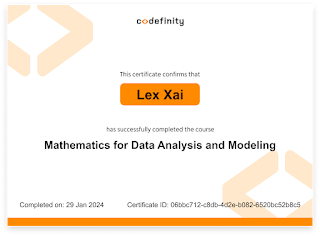These courses encompass the comprehensive study of key concepts, tools, and methodologies integral to the realm of data analysis and modeling.
By delving into courses centered around NumPy, Pandas, statistics, probability theory, as well as mathematics tailored for data analysis and modeling, learners are equipped with a well-rounded toolkit to seamlessly navigate the intricacies of data-driven exploration, manipulation, and inference.
The curriculum's diverse content ensures a robust understanding of critical elements in data science, cultivating a solid base for individuals venturing into this dynamic and ever-evolving domain.
 |
| Preparation for Data Science |
Courses of track:
- NumPy in a Nutshell
NumPy is one of the basic packages for scientific computing in Python. The 'NumPy in a Nutshell' course will introduce you to such a powerful tool as NumPy, which is convenient for working with arrays of different sizes. After completing this course, you will be able to easily work with matrices, using various functions. In addition, during the course, you will learn basic methods for working with arrays that simplify code writing.
NumPy in a Nutshell - Getting into NumPy Basics
In this project, we will delve into the fundamentals of NumPy, exploring its core features and uncovering the reasons behind its significant impact on scientific computing. By understanding its architecture and capabilities, we will grasp why it is considered an essential tool for data scientists, researchers, and developers working in the realm of data analysis, machine learning, and beyond.
Getting into NumPy Basics - Pandas First Steps
Pandas is an extremely user-friendly library for data analysis. It's also designed to handle large datasets, using data structures like DataFrame and Series. This makes it an invaluable tool for Data Science. In this guide, you'll get acquainted with a range of statistical functions, including how to find correlations, modes, medians, and maximum and minimum values within a dataset. You'll also learn how to handle missing values and manipulate specific values, as well as how to remove them.
Pandas First Steps - Advanced Techniques in Pandas
This course contains a lot of useful functions for a future data analyst. You will learn different ways of extracting data and even set conditions on it. After it, you will be familiar with the methods of grouping data. Also, you will learn how to preprocess data. Each section has its data set so that the course will be gripping.
Advanced Techniques in pandas - Unveiling the Power of Data Manipulation with Pandas
In this project, we are going to understand what Pandas is and why it is so powerful.
Data Frames, Import and Export Files, Filtering the DataFrame, Grouping in Pandas, Data Cleaning, Merging in Pandas.
Unveiling the Power of Data Manipulation with Pandas - Mathematics for Data Analysis and Modeling
To study many applied disciplines, it is necessary to have basic knowledge of higher mathematics and linear algebra. Mathematics is often used in data analysis, system modeling, building machine learning models, etc. Let's look at some of the most important topics and learn how to use the mathematical apparatus to solve real problems.
Basic Mathematical Concepts and Definitions, Linear Algebra, Mathematical Analysis.
Mathematics for Data Analysis and Modeling - Probability Theory Basics
Probability theory is a fundamental branch of mathematics that deals with the study of uncertainty and randomness. It provides a framework for understanding and quantifying uncertainty in various fields, including statistics, data analysis, machine learning, finance, physics, and more.
Basic Concepts of Probability Theory, Probability of Complex Events, Commonly Used Discrete, Distributions, Commonly Used Continuous Distributions, Covariance and Correlation.
Probability Theory Basics - Learning Statistics with Python
This course gives you a basic knowledge of statistics. It is intended for students with basic knowledge of Python syntax, as they will be working with NumPy and Pandas modules. During the course, you will become familiar with the basic concepts and then gradually move on to more complex concepts and tasks.
Basic Concepts, Mean, Median and Mode with Python, Variance and Standard Deviation, Covariance vs Correlation, Confidence Interval, Statistical Testing.
Learning Statistics with Python - Probability Theory Mastering
Statistics and probability theory are fundamental tools in data analysis, decision-making, and scientific research. They provide a systematic and quantitative way to understand and interpret data, make predictions, and draw conclusions based on evidence. Now we will consider all additional topics necessary for Data Science and Data Analytics.
Additional Statements From The Probability Theory, The Limit Theorems of Probability Theory
Estimation of Population Parameters, Testing of Statistical Hypotheses.
Probability Theory Mastering


Немає коментарів:
Дописати коментар